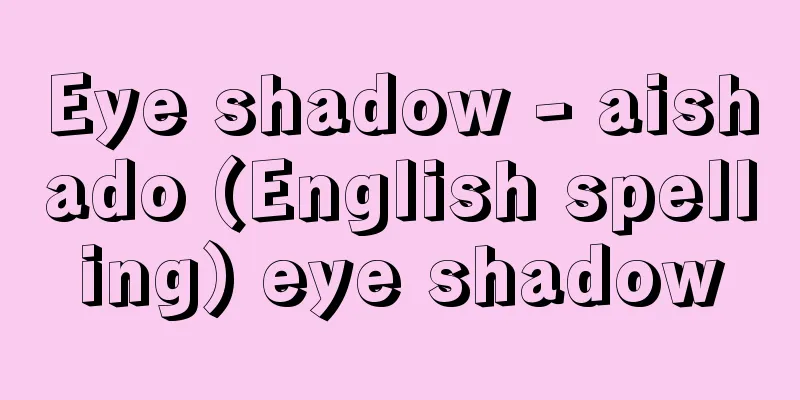Eye shadow - aishado (English spelling) eye shadow

|
Cosmetics applied to the eyelids. It is a makeup method that creates shadows around the eyes, and has the effect of making the whole face look three-dimensional. It originated in ancient Egypt, and is said to have been used to ward off evil or to protect against eye diseases. Two colors of dye, black and green, were used, with the black made from a type of clay mineral called corylite and the green made from malachite powder, to color the area around the eyes. This makeup method continued into the Greek and Roman eras, and was later passed down as a fashion to Arabian women who covered their faces with veils. However, it did not spread to Western Europe, where no women wore eyeshadow, but it was first used in the 18th century along with grease paint for stage makeup. It became common in the mid-20th century, when the focus of makeup is said to have shifted from the lips to the eyes, and since then, makeup that emphasized the eyes, not just eyeshadow, began to attract attention. Eyelid makeup in Japan is said to have begun with red clay makeup, and remains of clay figurines depicting people painting the area around their eyes red as a talisman. In the Edo period, people also wore rouge on the corners of their eyes. Eye shadow was imported to Japan during the Taisho period, and was made by the American company Mapellin. Eye shadow was domestically produced around 1933 (Showa 8), but at the time it was only used for stage performances or as evening makeup. Eye shadow is made from a base cream made of petrolatum, lanolin, etc., to which fragrances and organic pigments are added, and comes in a variety of types, from stick or paste-like solid applications to pencil and powder types in recent years. The colors range from browns, blues, reds, and pearl golds. The most common way to apply eye shadow is to apply it darkest at the base of the upper eyelashes, blend it out as you go up the eyelid, and then spread it from the inner corner of the eye to the outer corner. [Fumisako Yokota] Source: Shogakukan Encyclopedia Nipponica About Encyclopedia Nipponica Information | Legend |
|
瞼(まぶた)に塗る化粧料。目の周囲に陰影(シャドー)を描く化粧法で、顔全体を立体的に見せる効果がある。起源は古代エジプト時代で、魔除(まよ)けのためとも、目の病気から守るためともいわれている。黒と緑の2色の染料が使われ、黒は粘土鉱物の一種のコリライト、緑はくじゃく石の粉末が用いられ、目の周りを彩った。この化粧法はギリシア・ローマ時代にも続き、その後、ベールで顔を隠すアラビア女性におしゃれとして受け継がれた。しかし西ヨーロッパには伝わらず、アイシャドーを塗る女性はいなかったが、18世紀ごろ初めて舞台化粧のドーランとともに使われた。一般的になるのは20世紀なかば、メーキャップのポイントが唇から目に移ったといわれる時期からで、それ以後、アイシャドーに限らず、目にアクセントを置いた化粧が注目を集めるようになった。日本での瞼の化粧は赤土化粧に始まるといわれ、魔除けとして目の周りに赤く塗ったものが埴輪(はにわ)のなかに残されている。江戸時代、目尻(めじり)に紅をはく化粧もあった。アイシャドーがわが国に輸入されたのは大正期で、アメリカのメイペリン社製のものであった。1933年(昭和8)ごろアイシャドーが国産化されたが、当時はステージ用か夜のメーキャップに使用されたにすぎなかった。 アイシャドーの原料はワセリン、ラノリンなどを混合した基礎クリームに、香料、有機色素を加え、スティック(棒)状、練り状の固形塗りのものから、最近ではペンシルタイプやパウダータイプのものが多く使用される。色もブラウン系、ブルー系、紅系やパール・ゴールド系まで幅が広い。化粧法としては、上まつげの付け根へもっとも濃く、瞼の上へいくほどぼかし、目頭から目尻までに塗り分けるのが一般的である。 [横田富佐子] 出典 小学館 日本大百科全書(ニッポニカ)日本大百科全書(ニッポニカ)について 情報 | 凡例 |
Recommend
Silbermann, G.
…a family of German organ and keyboard instrument...
Foundation mortgage - Zaidan teito
In industrial, mining, fishing, railroad and othe...
Dezfūl (English spelling)
A city in Khuzestan Province in southwestern Iran....
Kanazawa Road
...To the east of Yoritomo's tomb is the anci...
Ayano Koji Family
The Uda Genji clan. The family of Eikyoku (traditi...
Arc Melting - Arc Youkai
...This powder metallurgy method was subsequently...
Crown gear - Kanhaguruma
Please see the "Bevel Gears" page. Sour...
Golden Seal Charter
…It is called the Golden Bull (Golden Document) b...
Remus
…the legendary king who founded Rome in 753 BCE. ...
Ctenomys talarum (English name) Ctenomystalarum
...Body length 15-25cm, tail length 6-11cm, weigh...
Intermezzo - Intermezzo (English spelling) Italian
The name of a type of song. The content varies de...
Cosmos Satellite
A series of artificial satellites from the former ...
Chorus-Yubungen (Chorübungen of the Municipal Music School) German
This is a three-volume choral textbook published ...
Dayānanda Sarasvatī
1824‐83 A modern Indian religious reformer. Also k...
Brodiaea laxa (English spelling)
…[Tora Saburo Kawabata]. … *Some of the terminolo...









